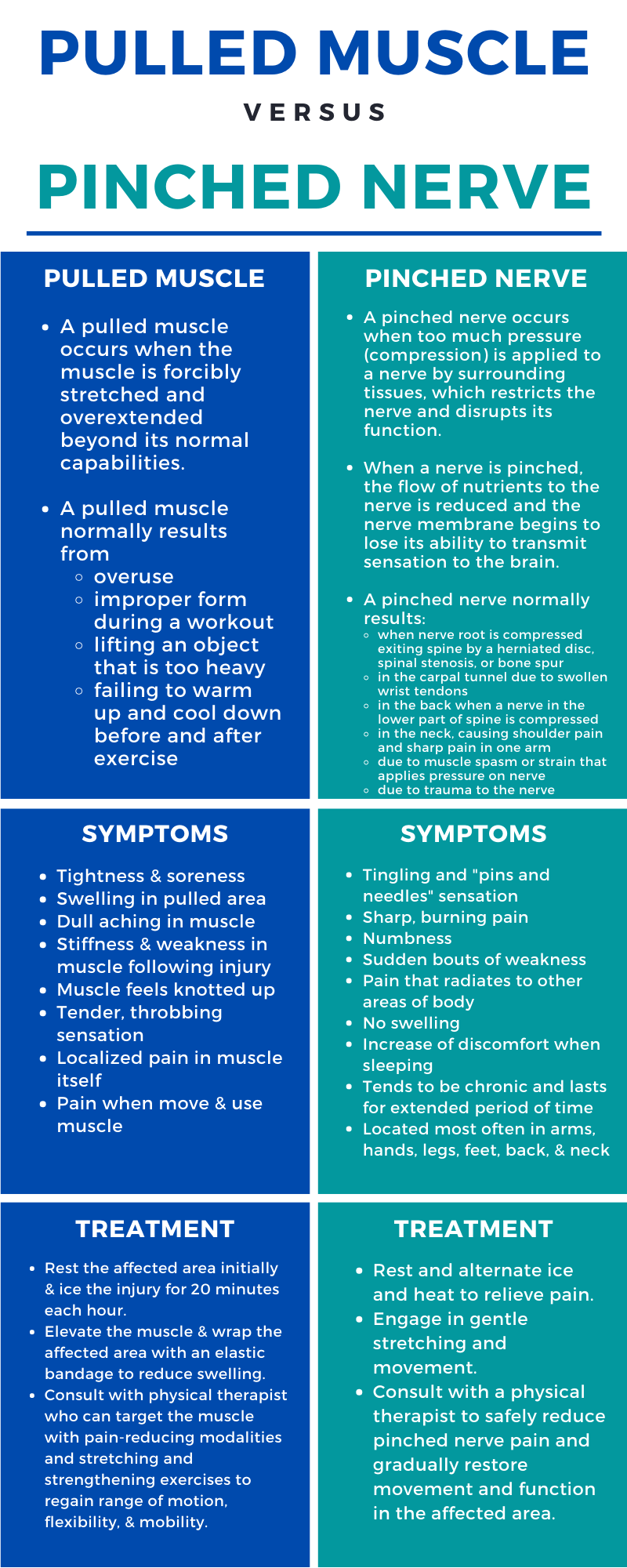Pulled Muscle vs. Pinched Nerve [Infographic]
How do you know whether you’re suffering from a pulled muscle or a pinched nerve? Both a pulled muscle or a pinched nerve may cause severe pain and limit your mobility, function, and ability to complete daily tasks. Being able to ascertain the difference between a pinched nerve and a pulled muscle is critical to ensure you receive the correct treatment and return to activity safely.
A pulled muscle may happen when the muscle is made to stretch and overextend beyond its natural ability. Pulled muscles often occur due to overuse, incorrect form during a workout, when lifting an object that is too heavy causing you to strain the muscle, and when you do not properly warm-up or cool down when exercising.
A pinched nerve results when too much pressure is placed on the nerve by surrounding tissues. This restricts the nerve and limits its function. When a nerve is pinched, the nutrient flow to the nerve is constrained, which causes the nerve membrane to lose its ability to transmit sensation to the brain effectively. Pinched nerves can develop in the carpal tunnel due to swollen wrist tendons, in the back when a nerve in the lower spine is compressed, in the neck resulting in shoulder and radiating arm pain, due to trauma to the nerve or a muscle spasm or strain that applies pressure to the nerve, and due to compression of the nerve root when the nerve exits the spine.
A pinched nerve and a pulled muscle have distinct symptoms. Symptoms of a pinched nerve include sharp, burning pain; numbness and sudden bouts of weakness; tingling sensation; no swelling; pain that radiates to other areas of the body; and chronic pain that lasts for an extended period of time. A pinched nerve is most often located in the arms, hands, legs, back, neck, and feet. Symptoms of a pulled muscle include swelling in the pulled area; dull aching, tightness, and soreness; stiffness and weakness in muscle after injury; tender, throbbing sensation; localized pain in muscle; and pain when moving or using muscle.
If you have experienced a pulled muscle, rest the muscle initially and ice the injury for twenty minutes each hour. Elevate the affected muscle and wrap it with an elastic bandage to reduce swelling. After a few days, you can apply heat to the affected area. If the pain does not subside, contact your physical therapist. The physical therapist treats a pulled muscle with pain-reducing modalities and guides you through stretching and strengthening exercises to help you regain your flexibility and mobility gradually and without aggravating the muscle.
If you are dealing with a pinched nerve, rest and alternate ice and heat to relieve pain. You can gently stretch and engage in light movement. However, it is imperative to consult with a physical therapist for a pinched nerve to safely reduce your pain and restore function and movement to the nerve and surrounding tissues.
By recognizing the difference between a pulled muscle and a pinched nerve, you can effectively treat the pain and address limitations on your mobility and function with the guidance of your physical therapist to prevent long-term chronic pain.
